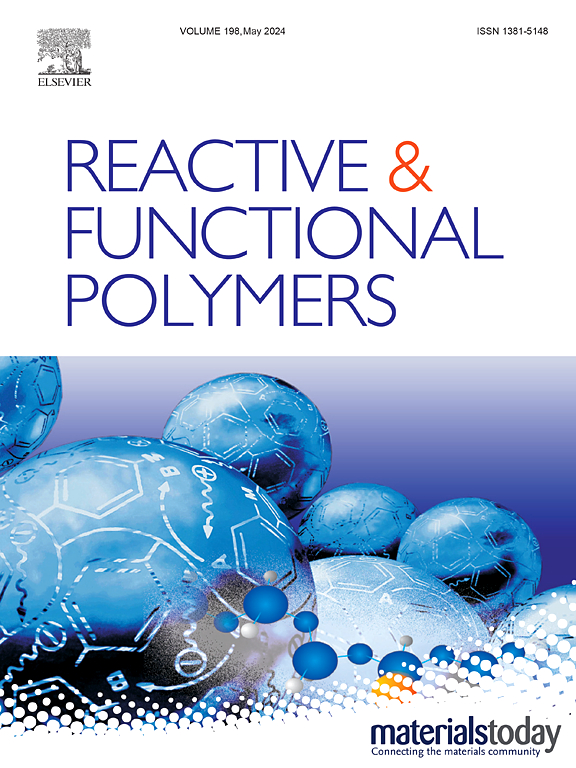用于3D/4D打印应用的聚对苯二甲酸乙二醇酯/热塑性聚氨酯(PETG/TPU)共混物的反应性和非反应性增容
IF 5.1
3区 工程技术
Q1 CHEMISTRY, APPLIED
引用次数: 0
摘要
近年来,由于3D和4D打印在多个领域的应用潜力巨大,因此对其的研究迅速增长。聚对苯二甲酸乙二醇酯(PETG)和热塑性聚氨酯(TPU)的聚合物共混物已成为此类应用的有希望的候选者。PETG具有良好的形状固定性,但恢复能力有限,而TPU作为弹性体,具有良好的形状固定性,但固定性较差。因此,将PETG与TPU混合为平衡这些互补的形状记忆特性提供了一种策略方法。然而,PETG和TPU之间的不混溶会限制其共混物的整体性能。为了解决这个问题,可以使用相容剂来增强界面附着力和稳定共混形态。本研究探讨了PETG和聚己内酯基TPU共混物的反应性和非反应性增容策略,旨在3D/4D打印应用。研究了三种增容剂:苯乙烯-乙烯-丁烯-苯乙烯(SEBS)、马来酸酐-功能化SEBS (SEBS- ma)和乙烯-甲基丙烯酸缩水甘油酯(E-GMA)。通过熔融混合制备共混物,挤压成长丝,并用于打印试件。进行了全面的分析,以评估形状记忆行为,以及化学,流变学,形态学和力学性能。结果表明,所有增容剂均增强了PETG/TPU共混物的形状记忆效应和力学性能。值得注意的是,使用E-GMA的反应相容性产生了最显著的改善。与未增容的共混物相比,E-GMA体系的形状回复率提高了~ 12.7%,机械性能也有所提高:杨氏模量提高了~ 20%,抗拉强度提高了~ 37%,断裂伸长率提高了~ 550%,冲击强度提高了~ 70%,达到超过650 J/m的值,这是超韧聚合物的特征。这些改进是由于界面张力降低,相附着力增强,增容共混物的形态稳定性提高,从而提高了印刷质量。总的来说,这项研究强调了相容化,特别是反应相容化,在提高先进3D/4D打印应用的非混相聚合物共混物性能方面的有效性,为高性能材料系统的发展铺平了道路。本文章由计算机程序翻译,如有差异,请以英文原文为准。

Reactive and non-reactive compatibilization of polyethylene terephthalate glycol/thermoplastic polyurethane (PETG/TPU) blends for 3D/4D printing applications
In recent years, research on 3D and 4D printing has experienced rapid growth due to its vast potential for applications across multiple fields. Polymer blends of polyethylene terephthalate glycol (PETG) and thermoplastic polyurethane (TPU) have emerged as promising candidates for such applications. PETG offers good shape fixity but limited recovery capability, whereas TPU, as an elastomer, provides excellent shape recovery but poor fixity. Therefore, blending PETG with TPU presents a strategic approach to balancing these complementary shape memory characteristics. However, the immiscibility between PETG and TPU can limit the overall performance of their blends. To address this, compatibilizers can be employed to enhance interfacial adhesion and stabilize blend morphology. This study explores reactive and non-reactive compatibilization strategies for PETG and polycaprolactone-based TPU blends, aiming for 3D/4D printing applications. Three compatibilizers were evaluated: styrene-ethylene-butylene-styrene (SEBS), maleic anhydride-functionalized SEBS (SEBS-MA), and ethylene-glycidyl methacrylate (E-GMA). The blends were prepared via melt blending, extruded into filaments, and used to print test specimens. Comprehensive analyses were conducted to assess shape memory behavior, as well as chemical, rheological, morphological, and mechanical properties. The results demonstrated that all compatibilizers enhanced both the shape memory effect and mechanical performance of PETG/TPU blends. Notably, reactive compatibilization using E-GMA yielded the most significant improvements. Compared to uncompatibilized blends, the E-GMA system exhibited a ∼ 12.7 % increase in shape recovery, along with enhancements in mechanical properties: Young's modulus increased by ∼20 %, tensile strength by ∼37 %, elongation at break by ∼550 %, and impact strength by ∼70 %, reaching values exceeding 650 J/m, characteristic of supertough polymers. These improvements were attributed to reduced interfacial tension, enhanced phase adhesion, and improved morphological stability in the compatibilized blends, resulting in superior printing quality. Overall, this study highlights the effectiveness of compatibilization, particularly reactive compatibilization, in improving the performance of immiscible polymer blends for advanced 3D/4D printing applications, paving the way for the development of high-performance material systems.
求助全文
通过发布文献求助,成功后即可免费获取论文全文。
去求助
来源期刊

Reactive & Functional Polymers
工程技术-高分子科学
CiteScore
8.90
自引率
5.90%
发文量
259
审稿时长
27 days
期刊介绍:
Reactive & Functional Polymers provides a forum to disseminate original ideas, concepts and developments in the science and technology of polymers with functional groups, which impart specific chemical reactivity or physical, chemical, structural, biological, and pharmacological functionality. The scope covers organic polymers, acting for instance as reagents, catalysts, templates, ion-exchangers, selective sorbents, chelating or antimicrobial agents, drug carriers, sensors, membranes, and hydrogels. This also includes reactive cross-linkable prepolymers and high-performance thermosetting polymers, natural or degradable polymers, conducting polymers, and porous polymers.
Original research articles must contain thorough molecular and material characterization data on synthesis of the above polymers in combination with their applications. Applications include but are not limited to catalysis, water or effluent treatment, separations and recovery, electronics and information storage, energy conversion, encapsulation, or adhesion.
 求助内容:
求助内容: 应助结果提醒方式:
应助结果提醒方式:


